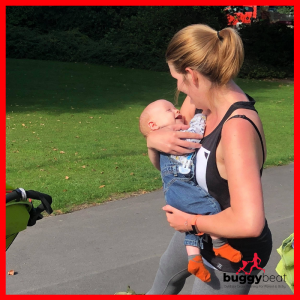As well as changes to your daily routine and sleep patterns, early motherhood also brings with it huge changes physically too!

Everyone is different and recovers at different rates- but in the first few weeks exercise should be the last thing on your mind.
But once you ARE ready to get back into fitness it can be quite challenging to understand what you CAN and CAN’T do as well as making the time with your new little one.
1. You can breastfeed and exercise
YOU CAN breast feed while exercising just remember to remain hydrated, your breast milk supply will not be effected by working out. We have ladies breast feeding during our Buggy Beat sessions and it is great to be surrounded by supportive Mums.
TOP TIP- invest in a good sports bra.
2. How to work your pelvic floor
When you can exercise after giving birth can vary greatly depending on each individual recovery, The Royal College of Obstetricians and Gynaecologists (RCOG) recommends that, ‘if pregnancy and delivery are uncomplicated, a mild exercise programme consisting of walking and pelvic floor exercises may begin immediately’.
You should begin by working on light and short contractions of your pelvic floor by lifting and holding the muscles.
3. Understand how your joints have changed
Before working out post-partum it’s important to understand the role of the hormone relaxin.
Produced around the second week of pregnancy, the role of relaxin is to soften the ligaments around the pelvis, preparing the body for labour.
However, the effects of this hormone cannot be isolated to one area, meaning the stability of all joints throughout the body will be compromised.
Post-natally, relaxin can remain in your system for up to five months and for breastfeeding mothers, even longer. As such it’s important to be aware of working within a comfortable range with all exercises, in particular weight lifting and stretching, in order to avoid injury by overloading the joints.
4. How to work the ABS
Contrary to what many believe, your abdominal muscles themselves do not stretch across the width of the growing bump – they separate along the middle.
You want to avoid traditional exercises such as crunches and sit-ups and instead perform gentle moves such as beginners’ planks (which you can progress as you develop strength), functional pelvic floor exercises and the ‘Superman’ pose.
5. Being outdoors has its benefits
Walking is recommended as a great way to begin exercising post-natally. Not only is it great to get your body moving again. but being outdoors has numerous health benefits too.
Fresh air is known to improve energy levels, boost a person’s mood, aid an effective digestion and strengthen your immune system.
Thats why our Mums feel so positive and energetic after out workouts!
6. Keep it low impact to start with
I would always advise waiting until your six week check before engaging in any higher intensity exercise. However, once you’re ready, low impact workouts are a great way to re-introduce exercise to your daily routine while minimising the pressure on your joints.
7. Get creative at home
As a new mum, finding time to hit the gym can be one of the biggest challenges of getting active, so home workouts become crucial to maintaining an exercise programme. Or try a Buggy Beat class once a week!
8. Workout in a team
Did you know that teaming up with one or more people to exercise has been proven to boost motivation and keep people on track? FIND YOUR BUGGY BEAT CLASS
9. Don’t forget to stretch
All too often people get carried away with HIIT training and weight-lifting but forget to slow down, stretch and rest.
Not only is stretching a crucial part of keeping your body healthy, but tight muscle won’t work properly, meaning that exercising without maintaining a stretching programme will decrease the efficiency of your workouts.

